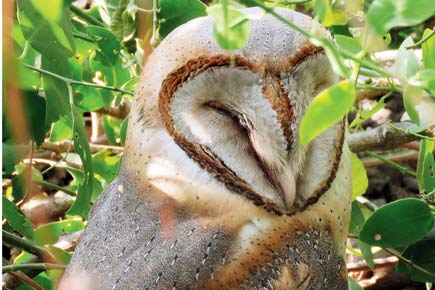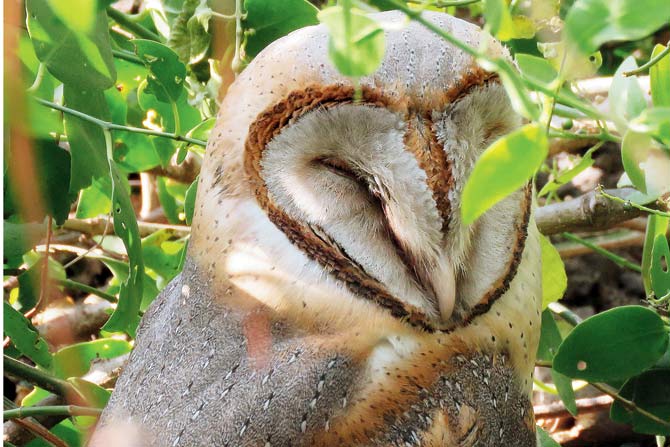A few years ago, while discussing Mumbai's health, I was aghast to know that there were nearly nine rats for every human in the Mumbai Metropolitan Region. This translates to a whopping 108 million rats at the lowest human population figure of 12 million.

The barn owl
 A few years ago, while discussing Mumbai's health, I was aghast to know that there were nearly nine rats for every human in the Mumbai Metropolitan Region. This translates to a whopping 108 million rats at the lowest human population figure of 12 million. That then, is literally a disease time bomb waiting to explode into an epidemic. It dawned on me that besides our housing, traffic and malaria-dengue woes, this issue should be a matter of highest concern among our urban planners. On checking with my sources, I realised that the problem doesn't even exist on the list of urgent urban concerns.
A few years ago, while discussing Mumbai's health, I was aghast to know that there were nearly nine rats for every human in the Mumbai Metropolitan Region. This translates to a whopping 108 million rats at the lowest human population figure of 12 million. That then, is literally a disease time bomb waiting to explode into an epidemic. It dawned on me that besides our housing, traffic and malaria-dengue woes, this issue should be a matter of highest concern among our urban planners. On checking with my sources, I realised that the problem doesn't even exist on the list of urgent urban concerns.
What was most worrisome was that the control of these menacing creatures, which can climb up to the fifth floor of buildings via pipes, was left to the individual.
ADVERTISEMENT

The barn owl
Most residents use rat poison, metal traps and new-age sticky charts that are not target specific and can also lead to the death of useful creatures like geckos, butterflies, honey bees, spiders and small birds. This definitely cannot be the best way to handle a deep and widespread problem. Obviously, closed disposal, public garbage control, segregation and better handling of mixed biodegradable and non-degradable waste are the long-term solutions. But considering the volume of waste Mumbai generates, and the unlimited food options the rats have, this seems like a near impossible dream.
As always, I turned to nature for a sustainable and non-biohazardous solution for the urban rat menace. The first thought that came to my mind was the thousands of swooping scavengers - black kites. But in just a week's observation, I realised that due to the primary nocturnal nature of rats, the diurnal kites consume very few stray rats that are active during the day or those struggling from rat poisoning. So, a more effective and permanent solution would be to zero in on a nocturnal predator. Suggesting snakes as an alternative would not garner popular acceptance due to the fact that some of them are venomous and have the potential of harming humans, too.
A few late night walks around my green neighbourhood in Tarun Bharat Society, Andheri, and the solution literally swooped onto me. It was silent and had a near perfect success rate. And there was zero chance of any harm to human life. I instantly realised that this was health and wealth packaged into one.
Some of you smart nature enthusiasts must have guessed our nocturnal saviour is the barn owl (Tyto alba). Not surprisingly, in Hindu Mythology, it is considered the vehicle - let's say the Ferrari - of Laxmi, the goddess of wealth and prosperity. By feeding on rats, barn owls not only prevent the spread of disease but also protect human resources like clothing, electrical wiring, urban crops and pipelines. The subterranean rat hideouts can cause immense damage to human property, not to mention the possibility of large-scale accidents.
Barn owls are most widely distributed landbird species and as studies have shown, make nests in any hollow, natural or man-made, sometimes even in residential towers. Their nightlong hissing and shrieking calls scare people, especially those fed on eerie Bollywood thrillers and Hollywood horror. But I remember being spellbound while watching a female owl disappear behind the lit display of a popular movie hall, where her clutch of four young awaited. Barn owls like all other owls are the epitome of parental care and both parents tend to their young. The near monogamous pair will do many sorties every night in search of frogs, mice, rats, lizards, locusts, snakes and roosting birds. Their near silent flight is achieved by a superb aerodynamic arrangement of feathers which is a matter of study in the warfare aviation industry.
Although our fair bird with a heart shaped face is an excellent and prodigious hunter, the excessive use of rat poison is leading to bioaccumulation in owls. An increasing number of disoriented and poison-affected barn owls have been rescued after flying into glass facades of buildings or have been hunted by crows, kites or dogs, transferring the poison into these unaware predators.
All types of owls have been a favourite since childhood and when one of these fairy-like birds lands on an electric light pole near my home, I can only but smile to myself and feel assured that health, wealth and prosperity is neigh.
Write in to Anand at sproutsonline@gmail.com
 Subscribe today by clicking the link and stay updated with the latest news!" Click here!
Subscribe today by clicking the link and stay updated with the latest news!" Click here!







